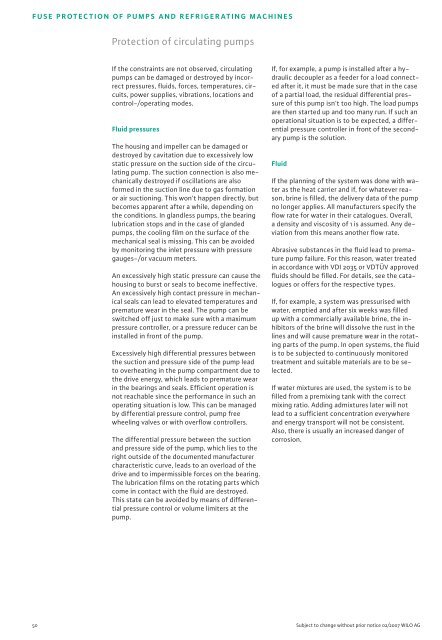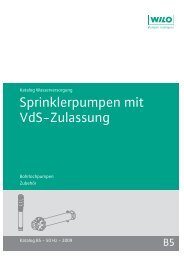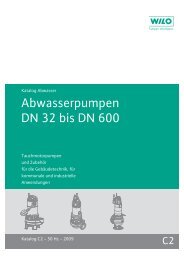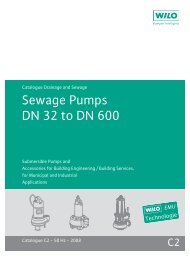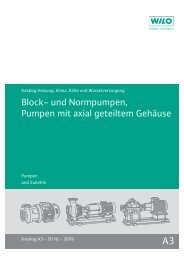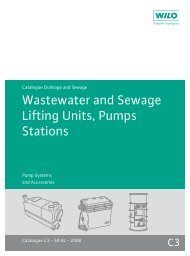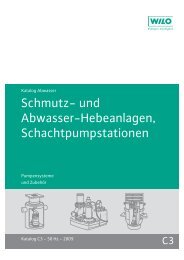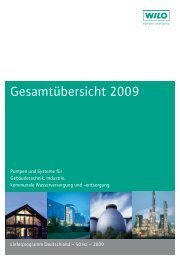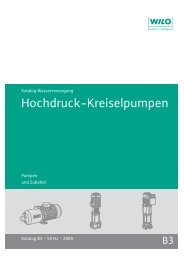Refrigeration, air-conditioning and cooling technology - 2007.pdf
Refrigeration, air-conditioning and cooling technology - 2007.pdf
Refrigeration, air-conditioning and cooling technology - 2007.pdf
Create successful ePaper yourself
Turn your PDF publications into a flip-book with our unique Google optimized e-Paper software.
PLH_KKK_32_85.QXP 25.05.2007 10:11 Uhr Seite 50FUSE PROTECTION OF PUMPS AND REFRIGERATING MACHINESProtection of circulating pumpsIf the constraints are not observed, circulatingpumps can be damaged or destroyed by incorrectpressures, fluids, forces, temperatures, circuits,power supplies, vibrations, locations <strong>and</strong>control-/operating modes.Fluid pressuresThe housing <strong>and</strong> impeller can be damaged ordestroyed by cavitation due to excessively lowstatic pressure on the suction side of the circulatingpump. The suction connection is also mechanicallydestroyed if oscillations are alsoformed in the suction line due to gas formationor <strong>air</strong> suctioning. This won't happen directly, butbecomes apparent after a while, depending onthe conditions. In gl<strong>and</strong>less pumps, the bearinglubrication stops <strong>and</strong> in the case of gl<strong>and</strong>edpumps, the <strong>cooling</strong> film on the surface of themechanical seal is missing. This can be avoidedby monitoring the inlet pressure with pressuregauges-/or vacuum meters.An excessively high static pressure can cause thehousing to burst or seals to become ineffective.An excessively high contact pressure in mechanicalseals can lead to elevated temperatures <strong>and</strong>premature wear in the seal. The pump can beswitched off just to make sure with a maximumpressure controller, or a pressure reducer can beinstalled in front of the pump.Excessively high differential pressures betweenthe suction <strong>and</strong> pressure side of the pump leadto overheating in the pump compartment due tothe drive energy, which leads to premature wearin the bearings <strong>and</strong> seals. Efficient operation isnot reachable since the performance in such anoperating situation is low. This can be managedby differential pressure control, pump freewheeling valves or with overflow controllers.The differential pressure between the suction<strong>and</strong> pressure side of the pump, which lies to theright outside of the documented manufacturercharacteristic curve, leads to an overload of thedrive <strong>and</strong> to impermissible forces on the bearing.The lubrication films on the rotating parts whichcome in contact with the fluid are destroyed.This state can be avoided by means of differentialpressure control or volume limiters at thepump.If, for example, a pump is installed after a hydraulicdecoupler as a feeder for a load connectedafter it, it must be made sure that in the caseof a partial load, the residual differential pressureof this pump isn't too high. The load pumpsare then started up <strong>and</strong> too many run. If such anoperational situation is to be expected, a differentialpressure controller in front of the secondarypump is the solution.FluidIf the planning of the system was done with wateras the heat carrier <strong>and</strong> if, for whatever reason,brine is filled, the delivery data of the pumpno longer applies. All manufacturers specify theflow rate for water in their catalogues. Overall,a density <strong>and</strong> viscosity of 1 is assumed. Any deviationfrom this means another flow rate.Abrasive substances in the fluid lead to prematurepump failure. For this reason, water treatedin accordance with VDI 2035 or VDTÜV approvedfluids should be filled. For details, see the cataloguesor offers for the respective types.If, for example, a system was pressurised withwater, emptied <strong>and</strong> after six weeks was filledup with a commercially available brine, the inhibitorsof the brine will dissolve the rust in thelines <strong>and</strong> will cause premature wear in the rotatingparts of the pump. In open systems, the fluidis to be subjected to continuously monitoredtreatment <strong>and</strong> suitable materials are to be selected.If water mixtures are used, the system is to befilled from a premixing tank with the correctmixing ratio. Adding admixtures later will notlead to a sufficient concentration everywhere<strong>and</strong> energy transport will not be consistent.Also, there is usually an increased danger ofcorrosion.50 Subject to change without prior notice 02/2007 WILO AG


